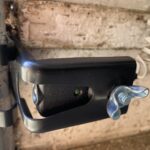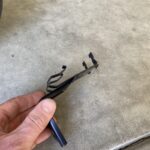The Chamberlain Group has been a long time powerhouse in the access systems industry. It manufactures three of the most common garage door opener brands in use today: LiftMaster (LM), Chamberlain, and Sears-Craftsman. For the last three decades it has co-dominated the residential opener market along with its competitor The Genie Company.
In my opinion, Chamberlain has always made the superior product. But there are still some issues with their stuff that drives me nuts. I will get to that later.
Also, keep in mind that mechanically, there is no difference between the Chamberlain brands. Motor parts and accessories are interchangeable. The LiftMaster belt and chain rail components are the only parts that can’t be swapped between brands (LiftMaster openers come with a one piece “T” rail. Chamberlain and Craftsman use a square tube rail that is broken into multiple parts so it can fit it in a box).
The top of the line Chamberlain made openers right now are the LiftMaster 8550W and 8500W. The 8500W is a jackshaft (a.k.a. “side mount”) opener, and doesn’t have an equivalent among Chamberlain’s other brands.
The LiftMaster brand is Chamberlain’s top of the line, and is only carried by professional installers.
LiftMaster 8550W and Equivalents
The 8550W is a traditional draw bar opener (pulls the door from an arm) with a D/C motor and belt drive, built in battery backup and wifi connectivity. It has equivalents in whatever Chamberlain is calling their top of the line opener at the moment. Advertised model numbers change all the time, but at the time of this writing Chamberlain B970 and B730 are equivalent machines. The biggest difference are the rails.
The LiftMaster rail is one long solid “T” shaped piece of metal. It is stronger than the square tube rail used by Chamberlain and Craftsman. It is also quieter, as the joints in the square tube rail can be squeaky. If you have a REALLY heavy door, some heavy duty LM models can be installed with an “I” shaped rail for extra strength and the ability to install an additional rail support.
Craftsman makes an opener that seems to be the same but advertises a 1.25 hp motor. This is stupid because it comes with a square tube rail that is too flexible for any door that would actually require 1.25hp (and 3/4 hp is plenty for just about any residential door anyway, even carriage style doors). Also, because the trolley(the part that slides down the rail) fully wraps around the square rail, it is impossible to add an additional support to the rail to prevent flexing under the weight of a heavy door. You aren’t getting anything here for opting for the extra power. But, if you have a typical residential door, this is an equally good option as the Chamberlain.
Chamberlain Chain Drive Openers
As far as Chamberlain manufactured chain drive openers, they are fine, and the new ones with a D/C motor are pretty quiet, too. If you opt for the old style A/C motor chain drive, it will be comparatively loud, and will eventually have the classic gear and/or sprocket failure.
The Chamberlain and Craftsman brands use the same square tube rail as on their belt drive openers. LiftMaster Chain drives feature the “T” rail.
There is no difference in reliability that I have found between the D/ C belt and chain openers as they are identical as far as the motor goes. If you want to save a couple bucks and don’t really care about the noise level, the chain option is fine.
Now for things that drives me nuts about Chamberlain products.
My Biggest Problem with LiftMaster and Chamberlain Openers
Chamberlain continues to use a 20 year old design for the safety eye mounting bracket that is utterly ridiculous. If there is a concrete “stem wall” right up against the track, you will not be able to clip them on at the proper height without a bunch of extra work blowing out some concrete. They are not adjustable or extendable in any way. They cannot be mounted to the same wall surface as the track is because they are short and will be blocked by the track. Anchoring into the concrete floor or wall is often the only option.


They are also easy to knock loose from the track since they just snap on. And since garage door track vibrates slightly as the door opens and close, the wing nuts that are used to tighten them down work their way loose, leading to misaligned eyes (easy to fix yourself, but annoying).
Chamberlain safety eye sensors are also “polar”, which means that there is only one way to connect the wiring — if you reverse the wiring when you connect it to the opener, it won’t work. This makes connecting to pre-existing wiring that is often inside the wall more of a challenge because you have to do multiple splices without mixing up the wires. It also complicates troubleshooting the wiring. Many other brands have “non-polar” safety eyes where the wires can go either way, a much easier system to deal with.
Conclusion
If you are planning on installing your own garage door opener, your best bet is probably a belt drive from Chamberlain or Craftsman. I definitely recommend their products over Genie or Overhead Door. However, if you are going to have a professional installation, there is another opener on the market that I consider to be a great option.